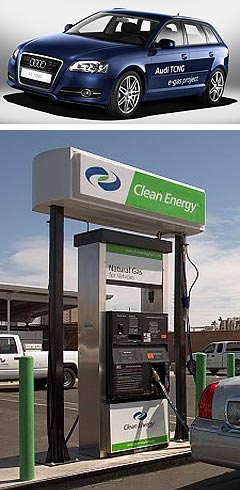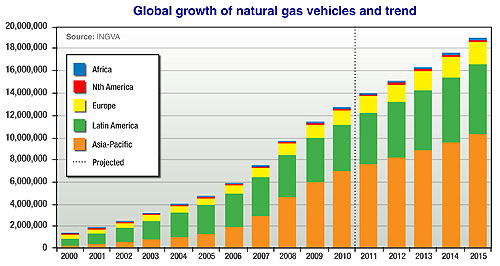News - Market Insight - Market Insight 2011Market Insight: CNG on the march – but not hereWhat a gas: Global numbers of natural gas-powered vehicles are increasing by 17.8 per cent per year. New report says Australia is making poor progress promoting compressed natural gas14 Oct 2011 By JOHN MELLOR COMPRESSED natural gas (CNG) vehicle numbers are booming around the world as countries seek energy security, reduced trade deficits and seek cuts in CO2 emissions, but Australia almost completely ignores the fuel in spite of its benefits. According to a new report on CNG vehicles titled ‘Natural Gas Australia: an Automotive Perspective’, countries like Pakistan and Iran have more than two million natural gas vehicles (NGVs) on their roads while Argentina, Brazil and India each have more than one million. By contrast, Australia has fewer than 3000 – mainly buses and trucks. The comprehensive report – the first in a new series on alternative fuels and powertrains by automotive benchmarking, consulting and reporting group ABMARC – is designed to give insights for businesses and governments into trends in the fuelling of cars and commercial vehicles. It highlights types of natural gas, sources, reserves, fuelling options and government policies in major world markets and also takes a detailed look at the NGV policy position in Australia. A digital version of the report includes a calculator covering the many variables in costs and charges to help fleet managers assess the benefits of NGVs.  Left: Audi A3 TCNG. Below: US CNG fuel bowser. Left: Audi A3 TCNG. Below: US CNG fuel bowser.The report says that NGV numbers worldwide are increasing by 17.8 per cent a year. In the past 10 years the number of NGVs on the road either manufactured or converted has increased from 2 million to nearly 13 million and the number is projected to reach more than 18 million by 2015. Natalie Roberts, principle engineering consultant at ABMARC, said many governments worldwide, including the US government and those in Europe, were actively promoting policies encouraging the use of CNG-powered vehicles in their transport industries. She said they see NVGs “as a way of increasing energy security, reducing the vulnerability of their transport industries to fluctuations in the price of oil and reducing their CO2 emissions”. CO2 emissions from an NGV are between 20 per cent and 25 per cent lower when compared directly to the petrol engine it replaces. Developing countries, especially in Asia-Pacific and Latin America, were making the switch to NGVs, led by Pakistan where around 60 per cent of the vehicle fleet now runs on CNG, with substantial benefits to vehicle emissions reduction and Pakistan’s terms of trade. In Europe, car-makers are now releasing factory models where CNG fuel is standard and carry normal warranties, the report said. However, the report highlights the poor progress made in Australia on NGVs, with less than 0.02 per cent of the national vehicle fleet using the fuel even though natural gas is piped past half the service stations, residential and commercial properties throughout Australia where vehicles could be fuelled from compressors extracting gas from the mains. This natural gas network is seen as a major existing benefit in the low-cost distribution of transport fuel throughout the population centres of Australia. “Australia’s extensive, existing transmission and reticulation network is an incredible asset which could be quickly leveraged to roll out station, depot and home fill capability for CNG vehicles,” said the ABMARC report. “Increased availability of refueling stations would likely assist in the uptake of CNG-fuelled vehicles in Australia.”Known Australian reserves of natural gas have tripled from 1993 to 2009 and, despite the expected increase in gas consumption, are expected to last 200 years. But ABMARC claims Australia has no visible policy to encourage the adoption of NGVs, with no appropriate standards for equipment and excise regimes that were likely to inhibit the adoption of NVGs. The report warns that planned excise increases on CNG mean that by 2015 Australians buying CNG at a service station would be paying about 60 per cent of the price of petrol. This would be the highest price for natural gas as a percentage of the petrol price anywhere in the world.  Read more |
Click to shareMarket Insight articlesResearch Market Insight Motor industry news |

















Facebook Twitter Instagram